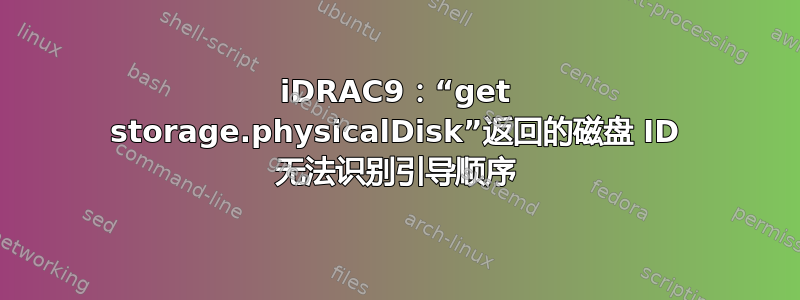
我在 PowerEdge R750 上使用 iDRAC9 (v5.10.10.00)。
get storage.physicalDisk显示它有一个磁盘AHCI.SL.6-1:
racadm>> get storage.physicalDisk
Storage.physicalDisk.1 [Key=Disk.Bay.0:Enclosure.Internal.0-1#PhysicalDisk]
Storage.physicalDisk.2 [Key=Disk.Bay.1:Enclosure.Internal.0-1#PhysicalDisk]
Storage.physicalDisk.3 [Key=Disk.Direct.0-0:AHCI.SL.6-1#PhysicalDisk]
但AHCI.SL.6-1设置时无法识别UefiBootSeq:
racadm>> set BIOS.UefiBootSettings.UefiBootSeq AHCI.SL.6-1
ERROR: BOOT016: Input source argument value for the boot device is incorrect or
not found among the boot devices on the system.
相反,我必须使用AHCI.SL.6-2:
racadm>> set BIOS.UefiBootSettings.UefiBootSeq AHCI.SL.6-2
[Key=BIOS.Setup.1-1#UefiBootSettings]
RAC1017: Successfully modified the object value and the change is in
pending state.
To apply modified value, create a configuration job and reboot
the system. To create the commit and reboot jobs, use "jobqueue"
command. For more information about the "jobqueue" command, see RACADM
help.
那么如何AHCI.SL.6-2使用 racadm 命令获取“正确”的磁盘 ID?
答案1
总而言之,他们过去使用完全限定的设备描述符 (FQDD) 来识别 UEFI 启动序列中的存储控制器。这样做的问题是,您可能拥有一个常规 RAID 卡,该卡有多个可启动的虚拟磁盘。例如,您最终可能会得到如下结果:
racadm>>racadm get BIOS.biosbootsettings.uefibootseq
[Key=BIOS.Setup.1-1#biosbootsettings]
UefiBootSeq=RAID.SL.8-1,RAID.SL.8-1,NIC.PxeDevice.1-1,NIC.HttpDevice.1-1,Floppy.iDRACVirtual.1-1,Optical.iDRACVirtual.1-1,AHCI.Slot.4-2
您有两个 RAID.SL.8-1 实例,但不起作用。因此,他们采取了 FQDD,然后按顺序指定可启动磁盘卷从...开始2. 我不知道他们为什么决定从 2 开始,但他们确实这么做了。随后,由于您的 BOSS 卡正在运行 RAID 1(我假设)并且它有一个可启动的虚拟磁盘 - 您最终只会得到AHCI.SL.6-2有效。由于您查看了物理磁盘,因此它只返回 FQDD。
如果你get bios.uefiBootSettings.UefiBootSeq这样做,你就会正确看到AHCI.SL.6-2。例如在我的盒子上:
racadm>>get bios.uefiBootSettings.UefiBootSeq
[Key=BIOS.Setup.1-1#uefiBootSettings]
UefiBootSeq=AHCI.SL.7-2,NIC.PxeDevice.1-1


